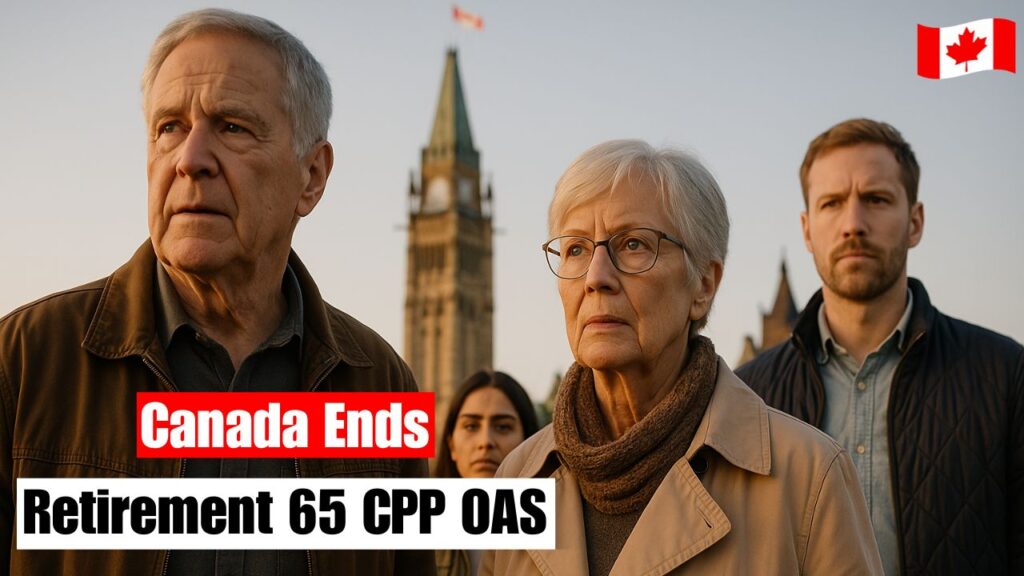Canada Signals End of Retirement at 65 – The Government of Canada has signalled a major shift in retirement planning by indicating that the traditional retirement age of 65 may no longer be the standard from 29 November 2025. This change affects millions of Canadians who rely on the Canada Pension Plan (CPP) and Old Age Security (OAS) as key sources of income. With life expectancy rising and labour shortages increasing, the country is preparing to adjust benefit rules, contribution expectations, and early/late pension options. This article explains all the new updates in a clear, human-friendly way to help readers understand how these reforms may impact their long-term financial plans.

Upcoming Retirement Changes for Canadian Citizens
The upcoming retirement changes expected for Canadian citizens are designed to modernize how CPP and OAS operate from 29 November 2025 onward. This shift reflects the government’s belief that age 65 is no longer a one-size-fits-all retirement benchmark for today’s workforce. Instead, Canadians may see updated contribution timelines, enhanced incentives for delaying benefits, and improved flexibility for those who must retire early due to health or employment conditions. These adjustments aim to balance sustainability with fairness, ensuring that older adults can maintain adequate support while the pension system remains financially stable for future generations. Many advocacy groups believe these changes could help reduce poverty among seniors, especially those living alone.
CPP Reform Measures for People Across Canada
CPP reform measures for people across Canada are expected to focus on long-term financial security and modern workforce needs. These measures may include revised early pension reduction rates, higher incentives for delaying CPP until age 70, and updated survivor benefits that better reflect modern family structures. The federal administration aims to account for rising living costs and longer lifespans, ensuring CPP continues to deliver meaningful support. Additionally, Canadians may benefit from simplified application processes, clearer eligibility guidelines, and enhanced digital access through the My Service Canada portal. With these reforms, households—especially those nearing retirement—are strongly encouraged to review their financial strategies well ahead of the 2025 changes.
| Policy Change | Expected Update (2025) |
|---|---|
| Standard Retirement Age | Potential shift away from fixed age 65 |
| CPP Early Pension Rules | Revised reduction rates for early claiming |
| CPP Delayed Benefits | Higher bonuses for claiming after age 65 |
| OAS Eligibility Adjustments | Review of income thresholds and age factors |
| Survivor Benefit Updates | Improved formulas for modern family needs |
OAS Payment Adjustments for Older Canadians
The announced OAS payment adjustments for older Canadians are expected to provide more targeted support starting 29 November 2025. As cost-of-living pressures continue to rise, the federal system plans to introduce refined income testing, potential enhancements for lower-income seniors, and more indexation options for those over 75. These adjustments may also impact how OAS integrates with GIS (Guaranteed Income Supplement) benefits. By updating income limits and adjusting inflation formulas, the government hopes to ensure that older residents do not fall behind financially. Individuals approaching retirement are encouraged to monitor these developments closely to understand how their future income may shift.
Future CPP–OAS Integration for Retirees in Canada
The future integration of CPP and OAS for retirees in Canada is expected to simplify how benefits are calculated and delivered. Policymakers aim to streamline the overlap between pensions, income supplements, and private retirement savings to reduce confusion for applicants. A more unified model could help retirees easily understand their monthly budgets while improving transparency around eligibility rules. This integration may also support better long-term planning by providing clearer projections and reducing administrative delays. These considerations are especially important as retirement patterns evolve due to longer careers and rising living costs.
Frequently Asked Questions (FAQs)
 CRA Confirms $533 GST/HST Payment for November 2025 — Updated 29 November Deposit Schedule
CRA Confirms $533 GST/HST Payment for November 2025 — Updated 29 November Deposit Schedule
1. When will the CPP and OAS changes begin?
The major adjustments are expected to take effect from 29 November 2025.
2. Is retirement at age 65 ending permanently?
No, but the age may become more flexible rather than a fixed national standard.
3. Will seniors receive higher CPP payments?
4. Should Canadians review their retirement plans now?
Yes, financial planning is recommended ahead of the 2025 changes.



